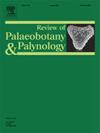冈瓦南记录中Portalites的古生态古地理特征。Hemer & Nygreen, 1967
IF 1.7
3区 地球科学
Q2 PALEONTOLOGY
引用次数: 0
摘要
门孢属是一个以圆形孢子为特征的属,具有功能性孔和光滑或装饰的表面,可归因于真菌界。所涉及的物种在冈瓦纳石炭纪和二叠纪的间冰期和冰期后沉积物的孢粉学准备中大量发现,但在当地直到三叠纪也有发现。该属包括5种:Portalites confertus(模式种)、P. gondwanensis、P. baculus、P. niger和P. rigidus。直接分析了巴西亚马amazonas (Monte Alegre组)和paranar本文章由计算机程序翻译,如有差异,请以英文原文为准。
Paleoecological and paleogeographical characterization of Portalites Hemer & Nygreen, 1967 in the Gondwanan record
Portalites is a genus characterized by circular spores with a functional pore and a smooth or ornamented surface, which can be attributed to the kingdom Fungi. The species involved are abundantly found in palynological preparations of interglacial and post-glacial deposits from Carboniferous and Permian of Gondwana, but they are also found locally up to the Triassic. The genus includes five species: Portalites confertus (type species), P. gondwanensis, P. baculus, P. niger, and P. rigidus. Materials derived from the Amazonas (Monte Alegre Formation) and the Paraná basins (Itararé Group and Rio Bonito Formation) in Brazil, ranging from the Pennsylvanian to the Cisuralian, were directly analyzed to understand the association of Portalites with the local flora. We observed that the studied species are primarily associated with Lycopsida and Filicopsida. Through the integration of lithological data, we identified that Portalites predominantly occurs in fine-grained sediments, indicative of low-energy, humid environments, and in proximity to freshwater or brackish conditions. In terms of paleogeography, the species exhibits its widest distribution in the Gondwana basins during the Pennsylvanian and Cisuralian.
求助全文
通过发布文献求助,成功后即可免费获取论文全文。
去求助
来源期刊
CiteScore
3.50
自引率
21.10%
发文量
149
审稿时长
6 months
期刊介绍:
The Review of Palaeobotany and Palynology is an international journal for articles in all fields of palaeobotany and palynology dealing with all groups, ranging from marine palynomorphs to higher land plants. Original contributions and comprehensive review papers should appeal to an international audience. Typical topics include but are not restricted to systematics, evolution, palaeobiology, palaeoecology, biostratigraphy, biochronology, palaeoclimatology, paleogeography, taphonomy, palaeoenvironmental reconstructions, vegetation history, and practical applications of palaeobotany and palynology, e.g. in coal and petroleum geology and archaeology. The journal especially encourages the publication of articles in which palaeobotany and palynology are applied for solving fundamental geological and biological problems as well as innovative and interdisciplinary approaches.

 求助内容:
求助内容: 应助结果提醒方式:
应助结果提醒方式:


